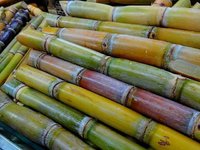Home page Rum About Rum
About Rum

Rum is derived from sugarcane, less commonly from fresh sugarcane juice, known as "Rum Agricole". The minimum alcohol content of rum is 37.5% by volume.
Rum is produced in tropical countries where sugarcane is grown. Major producing countries include the Caribbean, Central and South America, the Philippines, Australia, Madagascar, Mauritius, India, Réunion, the Canary Islands, Cape Verde, and some other countries.
For the production of rum, molasses or sugarcane juice is fermented and distilled with the addition of water. This slightly alcoholic mixture is often distilled multiple times, reaching an alcohol content of up to 80% after distillation. It is then diluted with clear water to a standard alcohol content of 40%, sometimes 50% or 55%.
Rum that is bottled immediately after distillation or only briefly aged in metal containers is clear and sold as white rum. However, rum, like whisky or cognac, is also aged in wooden barrels, often oak barrels, for years. Through this aging process, rum gains depth and a smoother, more rounded flavor, as well as a yellowish to brownish color. For aging, new barrels are sometimes used, but also used bourbon, whisky, or wine barrels are used to give the rum various flavor notes.
The diversity of rum types and flavors is influenced by the quality and flavor of the raw material, as well as the quality of the distillation process, the number of distillations, and the "composition" of the aging process in different barrels. There is a huge variety of taste and quality gradations. Taste is subjective, and ultimately, everyone must decide which rum tastes best to them. I offer a selection of recommended rum types. Some are my personal favorites, and I have also expanded my offering to include other high-quality types, without aiming to provide a complete range.



